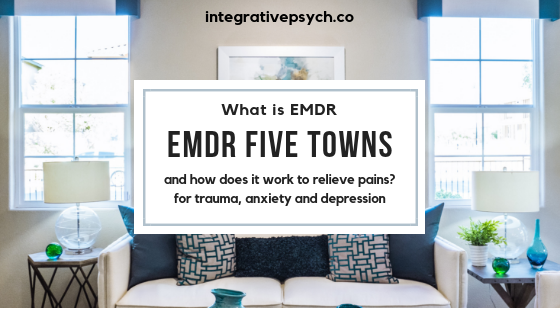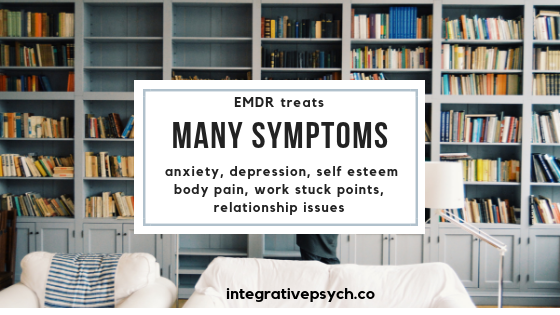EMDR Therapy in Five Towns, Long Island New York
EMDR therapy in Five Towns, Nassau County and across Long, Island and New York.
What is Eye Movement Desensitization and Reprocessing (EMDR)?
EMDR is a therapy that helps heal the Mind + Body. What we know is that the body has an innate capacity to heal itself, in the right environments. The mind, as well, has natural healing capacities, one specific coping mechanism is one that occurs during sleep, specifically during rapid eye movement (REM) sleep. Dr. Francine Shapiro developed EMDR in 1987 where she utilized the natural process of the mind to help individuals successfully process symptoms related to Post Traumatic Stress Disorder (PTSD). Over the last many years, EMDR and its uses have expanded to being used with great successes, in treating a wider range of mental health problems including self esteem, anxiety, relationship issues and work blockages.
EMDR originally was created to treat trauma.
What exactly happens to the brain when you are traumatized?
On an average day, your mind + body manage new information and experiences with ease; most often without you even being aware that you are processing changes, events, your brain is “quietly” doing all the work.
When something out of the normal happens that causes shock, and you are left feeling overwhelmed and powerless, you may be left feeling traumatized. This can happen from a single incident event such as a car accident or from being subjected to ongoing distress such as experiencing abuse or neglect in your childhood.
In such instances, your natural coping skills don’t suffice and you feel flooded. The leaving experiences then get “frozen” in your brain, as there were’t adequate skills to properly “digest” the information. This information, also referred to as “unprocessed data” gets stored in your limbic system of your brain. Why the problem? The information gets stored emotionally instead of getting stored as a narrative, in verbal form (which would feel like simple information but not emotionally charged).
Your limbic system is what holds emotional and physical sensations related to trauma memories. It holds the trauma memories in an isolated memory network which is completely disconnected from the brains’s cortex. The cortex is where we use language (verbal, narrative) to help process and store memories.
What happens with the trauma memories?
The memories can be triggered whenever you experience any kind of event, interaction or situation where you are reminded of the difficult experience you went through. What happens most often is that it isn’t necessary the “memory” that pops up when you are triggered, rather it’s the emotional triggers (also known emotional flashbacks) that cause the trigger. You can be triggered by painful feelings associated with fear, panic, anxiety, anger, rage, helplessness, despair or feelings of aloneness.
When your nervous system is hyper-activated, you will have a hard time connecting with yourself, being connected to others and feel distracted from learning from new experiences you’re going through.
Triggers inhibit you from fully living life in all areas of life; with self, in love, with family and work.
EMDR is a form of therapy that bridges the connections between the brain’s memory networks. Doing this, the brain is naturally able to process the traumatic memories, beliefs and sensations with ease.
EMDR in session:
As you now know, EMDR simply is a tool that strengthens and utilizes the mind + body’s healing capacities. You will first go through an assessment where you share about specific disturbing memory (or memories). After a thorough assessment, you will be asked specific questions about a particular disturbing memory. You will then get to practice different forms of eye movements, by your therapists asking you to watch his/her finger move forward and backward across your visual field. Other options are listening to headphones or using a tapping method that alternates buzzing sounds or vibrations from right to left. These movements are called bilateral stimulation, and this is what activates the same part of your brain that’s active in REM sleep.
The eye movements vary from short to longer sets, depending on what phase of the process you are and how your mind + body are responding to the treatment. There will be moments of pause where you will be asked to report on how you are doing, if there are any thoughts, images or simply what comes up.
You might notice a change in feelings, sensations, images or feelings. What often happens is that repeatedly using eye movements (or other bilateral movement) the intensity of the memory slowly changes. Over time the images/memories lose some of the intensity and shift to being more of “a verbal/narrative memory” that is neutral, and can be digested along with other regular events.
The triggers diminish and the information that was previously triggering will feel like “just another bit of info” that does not activate you.
Sometimes there are other memories or experiences associated to the memory you’re working on that will also feel relief. The brain links things up that are connected, so it is not uncommon to experience great improvements in larger aspects of your life than simply the one memory you were seeking to resolve.
What else can EMDR be used for?
Though EMDR is most popularly known to treat Post-traumatic Stress Disorder, EMDR has actually been effectively utilized to treat a broader range of symptoms including:
anxiety and panic
stress
phobias and fears
depression
complicated grief
pain relief
self-confidence and self esteem
performance anxiety
addictions
relationship issues
Is EMDR for everyone?
I don’t believe that every therapy is specifically helpful to everyone as each person’s brain and body process differently and at different paces.
For most, EMDR is often used as a trauma processing tool to accelerate treatment and help resolve issues that impact functioning. However, some individuals may have a difficult time with the discomfort that comes along with the processing. Processing brings up strong feelings, emotions and disturbing images, often for a short period, but it is important to know this occurs.
For some, taking some more time to get to build safety, learn stress relief skills and utilize other therapy methods first to help lessen the intense emotionality may be useful before choosing to engage in EMDR. As well, individuals with dissociative disorders first need to work on the dissociation in order for EMDR to be effective.
Most therapists use EMDR as a method integrated in their treatment, however, sometimes when the therapist isn’t certified as an EMDRIA practitioner, they may refer you to an adjunctive EMDR therapist. EMDR can take anywhere from 45, 60 to 90 minutes.
Does EMDR hypnotize me and am I still in control?
No, you are not being hypnotized and yes you are still in control. EMDR keeps you wide awake and does not induce hypnotic trance. You can choose to pause the process at any point in time if needed. Of course, a skilled, attuned therapist will help you as you process with EMDR and help you maximize your healing. Since EMDR happens best when the brain is processing, the less talk the better. Reprocessing happens spontaneously when you are supported and warmly guided with your therapist.
EMDR has helped many access their innate strength and feelings of empowerment.
Is EMDR evidence based?
EMDR has been researched rigorously. The reliability and validity is well established and has helped over a million people. At this point in time, EMDR is the one of the most thoroughly researched modality for trauma treatment. Right now there are at least nineteen controlled studies to keep this innovative treatment up to date with research and outcome datas of success.
The National Institute for Health and Clinical Excellence (NICE) highly recommends EMDR as an established, effective treatment for PTSD.
Are you seeking to experience relief from your nagging symptoms?
Live in Five Towns, Garden City, Hempstead, Long Beach or anywhere in Nassau or across Long Island or New York?
Feel free to reach out with any questions, I’d be happy to help!
Looking to try EMDR therapy today? As an EMDRIA approved therapist, I would be happy to begin helping you using EMDR. Schedule your session at my Cedarhurst office today.







